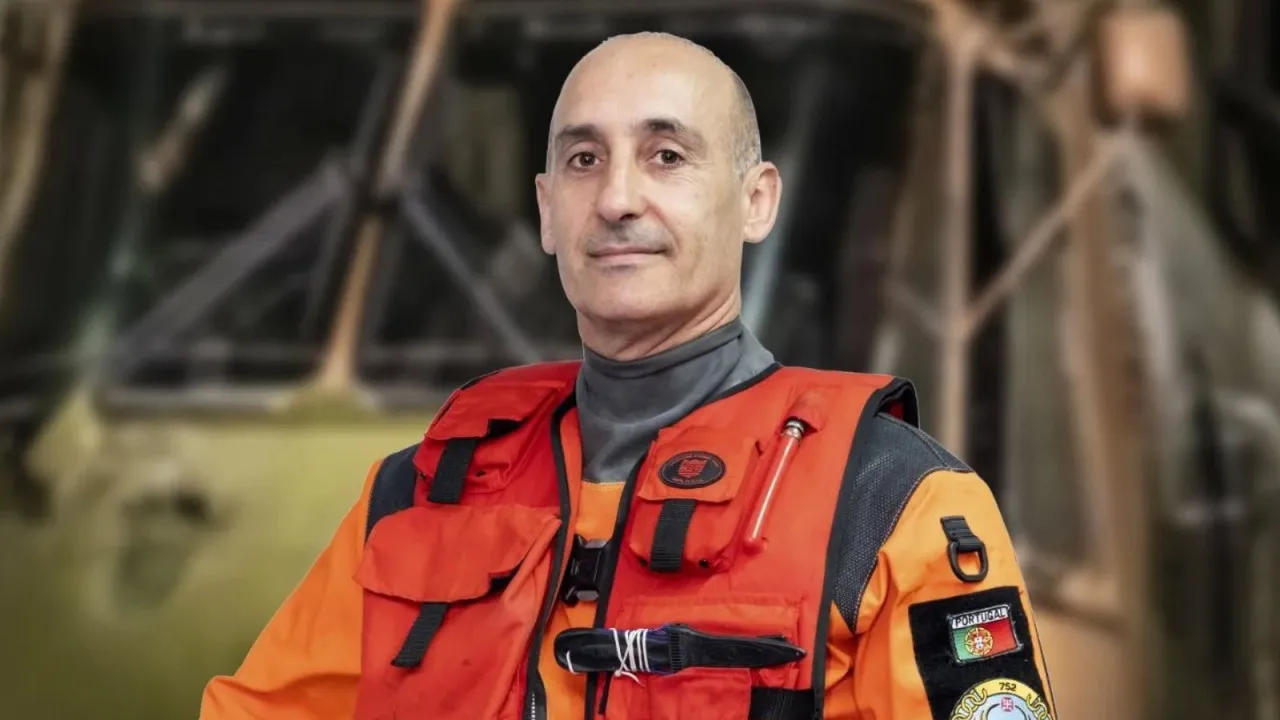
“This is the ideal scenario for search and rescue because it’s challenging every day. The weather conditions are very adverse, and it seems the place where we’re going to rescue is always the worst,” shares Vítor Casimiro.
At Squadron 752 – “Phoenix,” located at Air Base number 4 on Terceira Island, we meet Chief Sergeant Casimiro.
The corridor leading to various rooms where ground missions are prepared is lined with life jackets.
Each jacket tells a story of a rescue off the Azores, many bearing the name Vítor Casimiro.
Over 19 years, the rescuer has participated in 538 operational missions, including 272 “aeromedical evacuations” and 105 search and rescue missions, many conducted in the Azores.
Casimiro’s journey with the archipelago began early in his career but only in January was he assigned full-time to BA4. Originally from Bragança, he chose the Air Force for mandatory military service, fascinated by planes and helicopters.
During the five years stationed in the Azores, he decided to pursue a military career as a rescuer, influenced by the numerous stories told by those who went on life-saving missions.
He participated in the first rescue course for the EH-101 Merlin in 2006 and was stationed in Montijo, dividing time between the mainland, Madeira, and the Azores, where he had 15-day deployments.
Last week, Casimiro completed 3,000 flight hours aboard the Merlin during the rescue of a fisherman experiencing a stroke on a fishing vessel off Faial Island.
“We recovered the person aboard, left them in Faial, directly transferred to the plane which took them to São Miguel. Everything was very swift and well-coordinated. It’s good to work in such an environment because everything runs smoothly,” he reveals.
In August, with calm seas, the mission proceeded without much difficulty, but conditions are not always so forgiving in the Azores.
“There are many rescues with 10-meter waves, which is outrageous. We try to board a vessel – the smaller the worse – and face 10-meter waves, meaning the boat is down then suddenly up,” explains the Chief Sergeant.
During a rescue under similar weather conditions, Casimiro fractured a foot when boarding a fishing vessel. Being the sole rescuer aboard, he couldn’t abandon the mission.
“I only realized it when I tried to stand up and saw the foot was twisted backward. I didn’t feel pain. The adrenaline is so high at that moment that you don’t notice. Not being able to work standing, I knelt, equipped the man, and we left,” he recalls.
He underwent two surgeries, spent two months in the hospital, and four months in physiotherapy, always focused on returning to duty.
Giving up was never an option and at 50, Casimiro avoids thinking about when physical conditions might force him to stop undertaking missions.
“I love what I do. It’s as if you never get tired. After so many hours, you’re ready the next day because it’s a pleasure doing it,” he emphasizes.
“Gratitude from people is very rewarding. I’ve had people hug me, others cry just looking at us,” he adds.
It’s often upon returning to land and reviewing captured images that they grasp the mission’s difficulty.
“We’re so accustomed to these missions that we think it wasn’t so tough, but when we get back, we see the risks we took,” admits the Chief Sergeant.
The intervention area in the Azores is vast, with some missions involving approximately seven flight hours.
In 2015, several sailboats were caught in a storm off the Azores. Only the Kolibri was within the Portuguese Air Force’s reach, but at the maximum limit of 350 miles from the island of Flores.
Aboard the sailboat, which capsized two or three times amidst waves reaching 12 to 15 meters, were four Norwegians.
“That’s when I see the great trust people have in us. There were 10-meter waves when we arrived. The sailboat was up and down. I would hang on and when near the vessel, ask one to jump; they would jump, I’d go into the water, rescue them, and so on until the last,” recalls Casimiro.
The EH-101 Merlin had to refuel on Flores Island, at the maximum permitted to take off, and returned “at the fuel limit,” but safely landed.
Squadron 752’s walls hold many happy-ending stories, but not always can teams arrive in time.
“This is overcome with the next mission. Among ourselves, we don’t let anyone get down. We leave it behind, and next mission will go well, and we’ll save a life,” emphasizes Vítor Casimiro.
Established in 2023, Squadron 752 has limited human resources for the number of missions. Only one pilot commander is available, sometimes requiring reinforcements from Montijo.
“We hope the squadron will become huge one day. I believe those who come here end up building a life and staying longer than expected,” the Chief Sergeant notes.
Since 2012, Vítor Casimiro has been helping to train new rescuers, hoping they will bolster the Azores squadron.
“It’s gratifying to see them work. I have enormous confidence in their work because I know they’re prepared, otherwise they wouldn’t finish the course,” he highlights.




